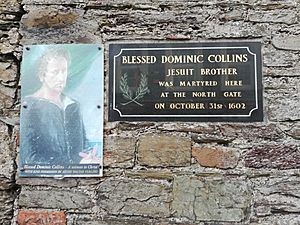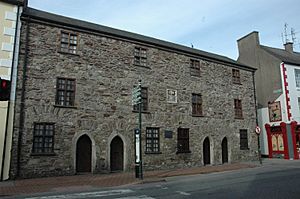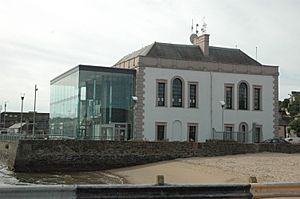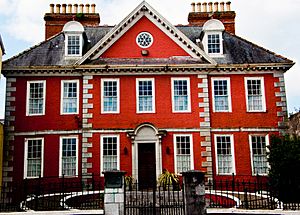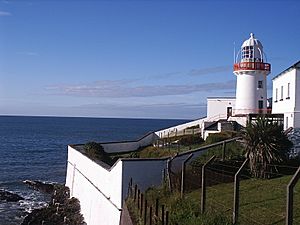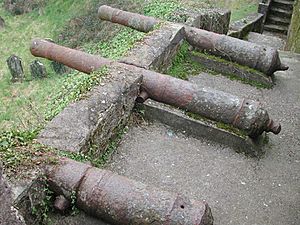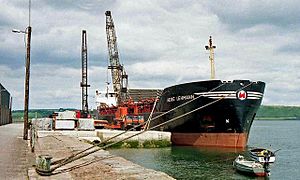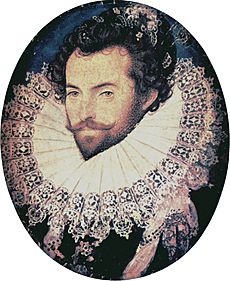Youghal facts for kids
Quick facts for kids
Youghal
Eochaill
|
||
|---|---|---|
|
Town
|
||
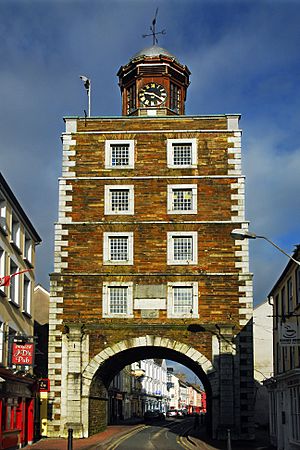
Youghal's Clock Gate is a symbol of the town
|
||
|
||
| Motto(s): | ||
| Country | Ireland | |
| Province | Munster | |
| County | County Cork | |
| Local electoral area | Midleton | |
| Dáil Constituency | Cork East | |
| EU Parliament | South | |
| Elevation | 0 m (0 ft) | |
| Population
(2022)
|
8,564 | |
| Time zone | UTC±0 (WET) | |
| • Summer (DST) | UTC+1 (IST) | |
| Eircode routing key |
P36
|
|
| Telephone area code | +353(0)24 | |
| Irish Grid Reference | X102781 | |
Youghal (/ˈjɔːl/ YAWL; Irish: Eochaill, meaning yew wood) is a lovely seaside resort town in County Cork, Ireland. It sits right on the River Blackwater estuary. Youghal used to be a very important place for military and trade. The town is built on the edge of a steep riverbank, giving it a long and narrow shape. In 2022, about 8,564 people lived there.
This historic walled seaport town is on the coast of East Cork. It's also close to many beautiful beaches. Because of this, Youghal has been a popular place for tourists since the mid-1800s. You can find many old buildings and monuments inside the town's walls. Youghal is even named an "Irish Heritage Port" by the Irish Tourist Board.
Contents
Youghal: A Historic Irish Town
What's in a Name?
The name Youghal comes from the Irish word Eochaill. This means "yew woods." Long ago, there were many yew trees in this area. You might also see older spellings like Youghall or Yoghel.
A Look Back in Time: Youghal's History
Youghal officially became a town in 1209. But people lived here much earlier! There were Viking settlements here in the 11th century. The Church of Coran, on the west side of town, dates back to the 5th century. There's even proof of people living nearby in the Neolithic (New Stone Age) period.
Important Buildings and Landmarks
Youghal has many old and interesting buildings.
- Myrtle Grove was the home of Sir Walter Raleigh.
- The St Mary's Collegiate Church is very old. It was likely started by St Declán around 450 AD. The church was rebuilt in a style called Irish Romanesque around 750 AD. A large Norman part was added around 1220. This church is special because it has been used for worship continuously since medieval times. The Vikings used Youghal for their raids. A stone in St Mary's Church even has an old drawing of a longboat.
In 1579, Youghal faced a difficult time. The town was damaged during a rebellion. Forces led by Gerald FitzGerald, 14th Earl of Desmond attacked the town.
The town walls were first mentioned in 1275. King Edward I gave permission for them to be fixed and made longer.
- Clock Gate Tower – This tower was built in 1777. It stands where Trinity Castle, part of the town's old defenses, used to be. The Clock Gate was used as a prison during the 1798 rebellion. It also served as a public jail and gallows until 1837.
- Tynte's Castle – This is a fortified house from the late 1400s. It's one of the few old fortified buildings left in Youghal. The Walsh family built it in 1602. Later, the Tynte family leased it. A map from 1663 shows it as one of the town's defenses. Today, it belongs to the McCarthy family.
- Alms Houses – These 17th-century houses were built by Richard Boyle, 1st Earl of Cork in 1602. They were for widows who needed help. Each widow received money to live on. Around the same time, Sir Richard Boyle also built a hospital and a free school. He was given the title Lord Boyle in 1616 for his work in Munster. His tomb is in St Mary's Collegiate Church.
- Youghal Town Hall – A new town hall was built in 1779. It replaced an older building. This new hall had a place for trading corn, a council room, a customs office, and a grand jury room.
- Water Gate – This gate was built in the 1200s. It gave people a way to get through the town walls to the docks. It's also called Cromwell's Arch. This is because Oliver Cromwell left Ireland from here in 1650. He had spent the winter in Youghal after his military campaign.
Youghal was also home to interesting people. In 1555, William Annyas became the first Jewish mayor in Ireland. The town also had a small but important group of Huguenot settlers.
- Youghal Priory – In 1350, the monastery of St John the Evangelist was founded. It was connected to a rich Benedictine monastery in Waterford. The main building looked like a mix of a fort and a religious place. Oliver Cromwell stayed at this Priory in the winter of 1649.
- Myrtle Grove – It's said that Sir Walter Raleigh brought the first potatoes from Virginia to Ireland in 1585. He planted them at his home, Myrtle Grove, in Youghal. He was mayor of the town for the next two years. Queen Elizabeth I gave him a lot of land in Youghal. He lived at Myrtle Grove and hosted the poet Edmund Spenser there. In the gardens, there are four yew trees that people say Raleigh planted.
- Red House – This is a brick townhouse from the early 1700s. It was built for the Uniacke family, who were merchants in Youghal. It was finished in 1703.
- Youghal Lighthouse – In 1202, a lighthouse was built on the cliff at the harbor's mouth. Nuns from a nearby convent were in charge of keeping the light burning. They did this until the 1530s. The current lighthouse is made of granite from Scotland. It was designed by George Halpin and started being built in 1848. The light was first shown in February 1852. The light is 78 feet (24 meters) above sea level.
Youghal as a Busy Port
Youghal has a long history as a port. In 853, Vikings built a fort here. This helped start Youghal as a trading seaport. By 1223, Youghal was so important that it had a special "road highway."
In 1291, merchants from Flanders traded in Youghal. King Edward I gave them special permissions. Many silver coins from the 1300s have been found in the Youghal area. This shows how much trade happened here. In 1301, King Edward I needed boats for a battle. He asked for three boats from Youghal, more than from most other ports. This shows how important Youghal was.
In 1353, people from Youghal could trade freely in England and Wales. They traded wool, leather, and lead. In 1376, the Mayor of Youghal received special privileges for helping against rebels. The people of Youghal also complained about having to go to Cork to pay customs. They managed to get a new system to pay customs right in Youghal.
In 1585, Youghal became one of the special ports where wine could be unloaded. In the early 1600s, Youghal became a "staple town." This meant it had special rights to trade wool with cities like Bristol and Liverpool. In the 17th century, Youghal was one of Ireland's main ports. It was even more important than Cork Harbour at the time.
In 1631, pirates often entered Youghal. One famous pirate was Nutt, who had three ships. By 1640, tobacco was a major trade item at Youghal port. Oliver Cromwell stayed in Youghal during the winter of 1649.
In 1697, many French Protestants, called Huguenots, came to Ireland. Some settled in Youghal. They brought new industries and ideas. By 1716, the Youghal council started making new rules. They wanted people to build quays along the waterfront. This helped the town grow by adding new land from the sea.
Trade in Youghal changed over time. In the 1750s, there were times when little corn or flour was imported. But then, exports of barley and oats increased. People also started working to improve the River Blackwater for navigation in 1755.
In 1762, a French privateer (a type of pirate ship) captured six ships near the harbor. By 1780, the wool business was very strong in Youghal. People made "great fortunes" from it. In 1781, Youghal exported more oats than any other port in Ireland.
In 1833, many ships entered the harbor. In 1834, there were 250 fishing boats. They employed 2,500 men. Salmon was very common and cheap. A steamer service started on the Blackwater River in 1843. This was meant to help trade with towns like Lismore and Mallow. However, the service stopped in 1850.
From the 1700s, some larger ships couldn't get into Youghal Harbour. This was because of a shallow sandbar at its mouth.
A ferry used to cross the harbor. Sadly, in 1876, the ferry capsized, and 14 people died.
In the 1950s, parts of the movie Moby Dick were filmed in Youghal. The town was used to look like New Bedford, Massachusetts.
Youghal used to have many factories. But in recent years, many have closed. This has caused job losses. Young people sometimes leave to find work in other cities like Cork or Waterford.
Youghal Today: Tourism and Fun
Beautiful Beaches
Youghal has several beaches. There's a 5-kilometer (3-mile) beach to the west of town. In 2011, Youghal's three main beaches—Front Strand, Claycastle, and Redbarn—received blue flags. This means they have clean water and good facilities. Ballyvergan Marsh, a large freshwater marsh, is along Claycastle and Redbarn beaches. It's home to many plants and birds.
In the mid-1900s, Youghal was a very popular seaside resort. Thousands of people came by train to the beach. It's even said that Sir Arthur Conan Doyle, who wrote Sherlock Holmes, vacationed here. He created a character called "Inspector Youghal" for one of his stories! The railway line closed in the 1970s. This caused a decline in tourism. But since the 1990s, there has been more effort to improve the town's facilities and bring back visitors.
Redbarn beach has a resort and homes nearby. There's a hotel, swimming pool, and other fun things. There's also a promenade along the coast.
Things to Do and See
Youghal has many things to do! You can find an 18-hole golf course, tennis courts, and pitches for GAA, soccer, and rugby. There's also greyhound racing and an indoor family entertainment center with bowling. You can visit art galleries, a snooker club, and a museum. There's even a special place for birdwatching at Ballyvergan Marsh.
Youghal was named one of the tidiest towns in Cork in 2012.
The Youghal Pipe Band was started in 1914. They even appeared on a BBC show in 1984! In 1993, they were invited to perform in France. The St Mary's Brass and Reed Band was founded in 1969. They have won many competitions.
Youghal has hosted the Irish Ironman Triathlon in 2019, 2022, and 2023. This is a big event where athletes swim, bike, and run long distances.
Getting Around Youghal
Cork Airport is the closest airport, about 54 kilometers (34 miles) away. Bus Éireann has services between Youghal and Cork city. Other buses go to nearby towns like Ardmore and Waterford City.
The Youghal railway station opened in 1860. It closed for passengers in 1963 and completely in 1982.
Famous Faces from Youghal
- William Annyas was elected Mayor of Youghal in 1555. He was the first Jew to hold such a position in Ireland.
- Richard Boyle (1566–1643) was closely linked to Youghal. He bought the town as part of his land from Sir Walter Raleigh.
- Claud Cockburn (1904–1981), a journalist, lived in Raleigh's house, Myrtle Grove, for many years.
- William Cooke Taylor (1800–1849), a writer and historian, was born in Youghal.
- Christy Cooney became the head of the Gaelic Athletic Association (GAA) in 2009.
- Katherine FitzGerald (died 1604) lived nearby. She is said to be buried in Youghal.
- John Huston (1906–1987) filmed parts of Moby Dick in Youghal.
- Florence Newton (around 1661) was known as the "Witch of Youghal." Her trial is an important example of Irish witch trials.
- Jake O'Brien (born 2001) grew up in Youghal and played for the local football club. He now plays for a French club.
- Eddie O'Sullivan (born 1958) was born in Youghal. He used to be the head coach for the Ireland national rugby union team.
- Walter Raleigh (c.1552–1618) was Mayor of Youghal in 1588 and 1599. He lived at Myrtle Grove.
- Davy Russell (born 1979) is a famous horse racing jockey.
- William Trevor (1928–2016), a novelist, spent some of his early years in Youghal. He even wrote about the town in one of his short stories.
Images for kids
-
Youghal town arms mosaic
See also
 In Spanish: Youghal para niños
In Spanish: Youghal para niños




